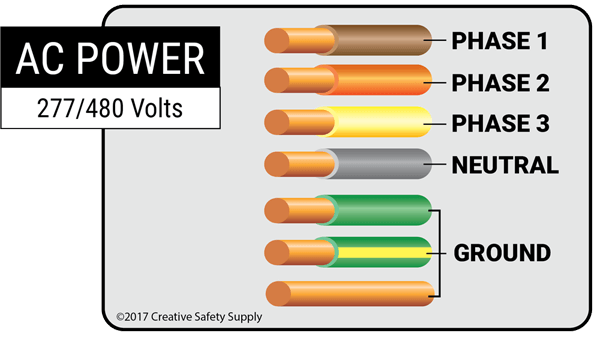
Following well-established wire color codes is essential. These color codes exist to ensure employees working with and around dangerous electrical equipment can work safely, effectively, and stay compliant with the National Electric Code.
In most facilities, electricity will come in at one point in the building and then be distributed to just about every corner through a series of wires. While electricity is used constantly throughout the day without much thought, it has the potential to cause many issues and even impede work altogether if managed incorrectly. That said, if the electrical system is not wired or labeled properly, it can result in injuries, deaths, fires, and many other problems.
Electricity is an essential component for virtually every step within manufacturing. Not to mention every home, school, distribution center, and anywhere else that can be thought of. Our communities run off electricity—but with great power comes great safety obligations!
The Different Types of Wire Color Codes
There are a number of different wire color code standards in place, so it is important to understand which one to follow depending on the unique situation. The standards used will vary based on the country where the wiring is being done, the type of electricity used, and several other factors such as voltage, cables, and circuits.
Learning about the different options that may be used in each electrically based situation is essential for workplace safety.

Wire Marking Colors for DC Power
Direct current power, or DC power, runs in a straight line. While a more consistent form of voltage delivery, DC power cannot travel the same long distances as AC power. DC power is used in batteries, solar cells, and fuel cells, as a few examples. It can also be made from AC power with the help of a rectifier.
When wiring for DC power, there are typically going to be either two or three wires. The coloring is as follows:
- The positive current must be red.
- The negative current must be black.
- The ground wire, if present, must be white or grey.

Wire Colors for AC Power
Alternating current, or AC power is what you will find coming out of power outlets in standard homes and businesses in the United States. This type of power is unique in that the flow of charge can periodically change direction.
The current of AC power moves in a sinusoidal AC wave. This wave-like motion causes AC power to be able to move further than DC power, which is the advantage of ferrying power to consumers from one location.
AC power comes in many different types based on how many volts the wires will be carrying. It is important to note that with this type of wiring, there are multiple phases in place, each of which will get its own color wire to make it clear what it is for those working on it.
For wires that will be 120, 208 or 240 volts, the following wiring color standards are used.
- Phase 1 wiring should be black.
- Phase 2 wiring should be red.
- Phase 3 wiring should be blue.
- Neutral wiring should be white.
- Ground wiring can be green or green with a yellow stripe.
In some uncommon situations, one phase will have a higher voltage than the others. These are known as high-leg connections. While rare, they can be identified by looking for a wire that is marked with orange, which will be the higher voltage wire.

High-Voltage Wire Color Code
These high-voltage connections are quite common in many manufacturing and other industrial areas. Due to the serious potential for deadly electrocution or other issues, getting these color codes right is essential. 277/480
- Phase 1 wiring should be brown.
- Phase 2 wiring should be orange.
- Phase 3 wiring should be yellow.
- Neutral wires should be grey.
- Ground wiring should be green, or green with a yellow stripe.
These are the wire color coding standards that are used in the United States. In Europe and other countries, there are different standards in place. This also stands true for machines made overseas for use in America. These will be wired according to US color standards. However, taking the time to confirm this before using the machinery is always a smart safety step.
The Color-Coding Essentials of Data Wiring
Another important aspect of electrical safety to keep in mind revolves around any data wiring within the facility. Cables that are used to transmit data for computer systems are often thought to be harmless since they are carrying information rather than electricity.
Some types of networking cables will have enough electricity flowing through them to cause a hazard. Certain devices, such as phones, will just need the 'power over Ethernet' which means they get the electricity that is needed from the network cable they are connected to. If someone cuts into these wires, or they become frayed, they can present a risk of shock or fire.
Data cables are typically colored based on the needs and standards of the facility rather than the electrical standards due to the lower voltages. However, applying labels or warning signs near these types of cables can serve as a good reminder of the potential risk of shock.
Labeling Electrical Wiring & Conduits
The wire color codes used only apply to the wires that are carrying electricity. In many cases, a bundle of these colored wires will be grouped together and sealed within black or grey cables. This helps to protect people from accidental exposure and makes it much easier to run the wiring where it needs to go, especially for higher voltage situations.
When this is the case, it is important to take the time to properly label the wires and electrical conduits to warn people of potential dangers. By using an industrial label printer, it is easy to identify every set of wires with information about how much electricity is present, where the wiring is coming from, and where it is going.
Placing warning signs anywhere that someone might interact with electrical wires, especially high-voltage wires, is another good idea for improving overall safety. These signs will serve as an excellent reminder to those in the area that there are dangerous wires present.
Effective Training Options for Recognizing Wiring Color Codes
Those who work directly with electrical wiring daily will need to be initially trained on what each of the wiring color codes mean. However, once they are performing their job regularly, it will become second nature.
Those who don't work directly with wiring regularly also need to receive this type of training, and in many ways, it is even more important. Without proper guidance, training, and documentation, they could put themselves or the entire facility at risk if they need to interact with wiring in any way.
Anyone who will have any exposure to electrical wires should have at least a basic understanding of the wire color codes.
Perhaps more important than even direct training will be ensuring everyone knows where to reference the color codes. Facilities should have some sort of reference material, which could be a poster, a book, a computer system, etc. However the information is conveyed, it needs to be easily accessible.
Applying Updated Color Standards to Existing Wiring
If there are wires in a facility that were put in place prior to the standards that are now used, it is important to take steps to address this safety concern. One option is to remove and replace all the wiring in the facility. Older wiring may have other safety related issues, so this can be a good solution in those situations.
If that is not possible, applying wire labels every few feet is another way to convey the necessary information that would otherwise be indicated by the color of the cable. This can be a good, affordable solution for bringing older wiring up to a better safety standard.
Similar Articles
- Neutral Wire Color
- Electrical Wire Colors
- Safety Colors (OSHA Guidelines and Color Codes)
- ANSI Color Codes for Pipe Marking
- Pipe Color Codes – ANSI/ASME A13.1
- Labeling Electrical Conduits
- ANSI TIA 606-B Cable Labeling Standards
- Arc Flash and Electrical Safety
- 10 Essential Steps for Electrical Safety


